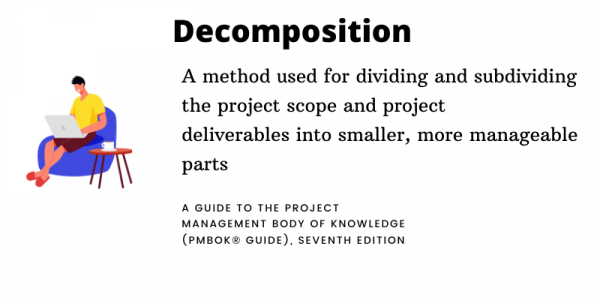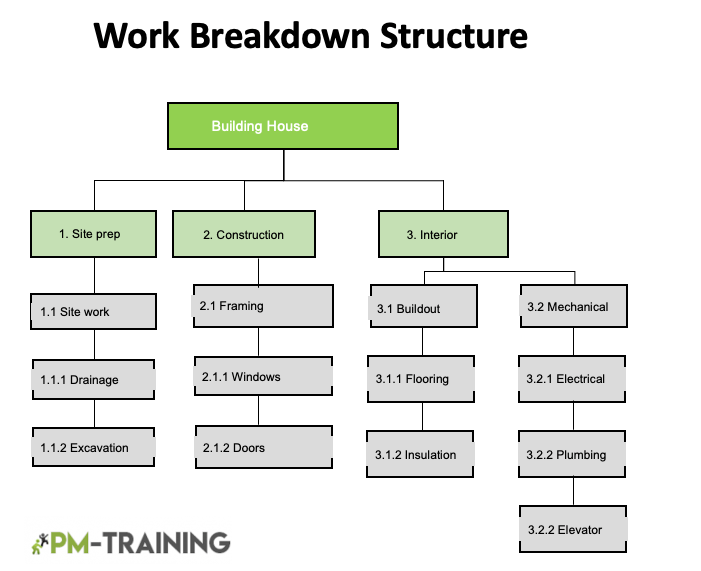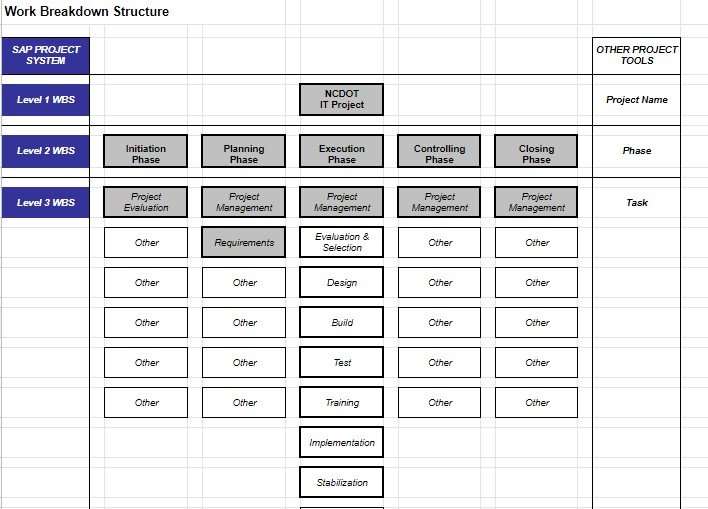Decomposition in project management is used to break a large project down into smaller, more manageable pieces. This is often done by creating a work breakdown structure (WBS), which is a hierarchical list of all the tasks and subtasks that need to be completed in order to finish the project.
When it comes to the Scope Management of the PMI Project Management Professional (PMP)® test, decomposition may be the most crucial concept to comprehend. By decomposing your project, you can more easily create a timeline and budget for the project. Allowing you to identify which tasks need to be completed first and which can be done concurrently. This helps to prevent scope creep and keeps your project on track.
Key characteristics of decomposing a project
Using a WBS by breaking a project down into smaller pieces, it becomes easier to plan, execute, and monitor progress.
Decomposition in project management can also help to identify risks and potential problems early on, which can save time and money in the long run.
If you’re thinking of starting a decomposition project management strategy for your next project, here are a few tips to get you started:
1. Define the overall goal of the project and the objectives you hope to achieve.
2. Break the project down into smaller tasks and milestones.
3. Assign responsibility for each task to a specific team member or contractor.
4. Create a timeline for each task and milestone.
5. Monitor progress

How to Decompose your Project

You will need to determine what the project is supposed to achieve and what the end product will look like. Start by breaking the project down.
Identify all of the deliverables for your project
To start with decomposition in project management, the first step is to identify all of the deliverables for your project and break the project down by task, component, or milestone. A deliverable is a tangible or intangible product that is produced as part of a project.
For example, a deliverable can be: A report, a Software application, a website, or a training course
Once you have identified all of the deliverables, you can then start to break them down into smaller tasks
Organize the WBS structure
Start by identifying the major tasks necessary to complete the project. These tasks should be listed at the top level of the WBS. Once the major tasks have been identified, break each one down into smaller, more manageable tasks. These tasks should be listed beneath the major tasks in the WBS.
Break down the major WBS into smaller tasks
Divide the higher WBS levels into more specific, lower-level components
Assign an identification number or code to track each task
When the project is divided into smaller parts or modules. Each milestone is then further decomposed into individual tasks. Once all the tasks are identified, they should be assigned to specific team members.
Make sure the resultant tasks are doable
Check that the degree of every component of the deliverables is reasonable. Simply put, ensure that the resulting tasks are manageable, achievable, and possible
Check costs
Some operations and tasks will have time-based expenses, while others will require specific resources, which will incur prices.
Free WBS Templates
Check 39 WBS Template for Excel, Google Docs + Sheets here

Agile Project Decomposition
There are a few different agile methods that can be used for decomposition in project management, For example, The story-based decomposition:
Story-based decomposition involves breaking the project down into smaller stories or tasks from epics.
Epics are typically used in agile development to describe the high-level functionality of a product or system.

The following is an example of how an agile project might be decomposed using a user story template:
-Epic: As a Customer, I want to buy my products on this eCommerce website and keep track of them.
– User story 1: As a customer, I want to be able to find the products on the website.
– User story 2: As a customer, I want to be able to view my account information.
– User story 3: As a customer, I want to be able to view my order history.
– Task 1: Create the database for the customer account information.
– Task 2: Develop the login page for the website.
– Task 3: Create the account information page.
They help to break down complex projects into smaller, more manageable pieces that can be delivered incrementally. By doing so, they help to ensure that the product or system is delivered with the desired functionality and quality.
Benefits of Decomposing your project
There are many benefits of decomposition in project management into smaller tasks. By breaking down a project into smaller parts, you can
More easily identify the resources you need and plan your work more efficiently
Additionally, it can help you stay organized and on track by creating a clear work breakdown structure.
Finally, breaking a project into smaller tasks can also help reduce stress and anxiety by making the overall project seem more manageable.
Excessive Decomposition
Decomposition in project management is an important tool, but it can also be one of the most abused. When decomposing a project into smaller pieces, it’s important to strike the right balance.
Too much decomposition in project management can lead to micromanagement and can make it difficult to see the big picture. On the other hand, too little decomposition can make it difficult to track progress and make changes as needed.
So how can you tell if you’re decomposing a project too much? Here are a few signs to watch out for:
- You’re spending more time managing the tasks than actually doing the work.
- You have a hard time seeing how the tasks fit together to achieve the overall goal.
- You find yourself making a lot of changes to the tasks as you go.
If you’re decomposing your project tasks too much, try to consolidate some of the smaller tasks into larger ones. This will make your project workflow more manageable and hopefully help you avoid any unnecessary delays or disruptions.
FAQs
What is Decomposition in Project Management?
Decomposition in project management technique is the process of breaking down a large project into smaller, manageable pieces. This is done so that the project can be completed more efficiently and effectively.
When is it right to use the Decomposition Technique?
It is important to consider this technique should be performed during the planning phase
What are the main steps of this Technique?
Identify the deliverables, organize the WBS Structure, break down the major WBS to smaller tasks, assign an identification number or code to track each task, make sure the resultant tasks are doable, and finally, Check its costs.
What is Decomposition in Agile?
Agile project decomposition is the process of breaking down a project into smaller, more manageable pieces. This is typically done at the beginning of a project, in order to create a roadmap for the project team.
